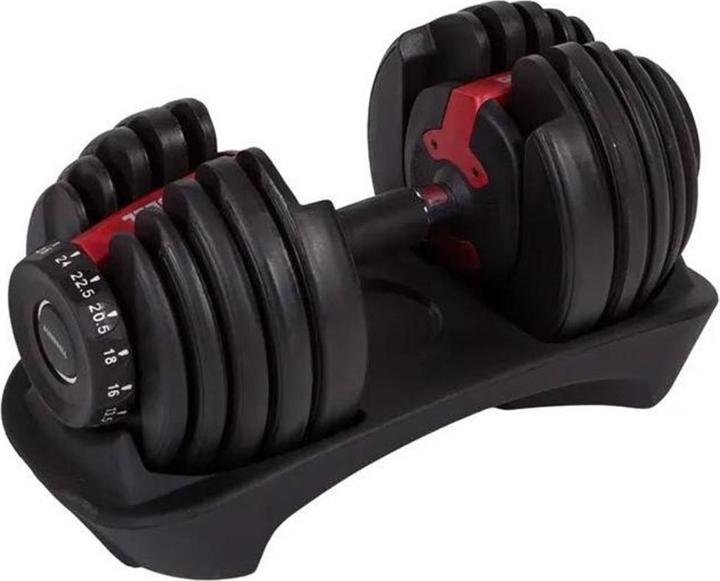

15 dumbbells in one: a review of Fitcom’s adjustable dumbbell
Strength training at home? Sounds good. If you don’t have tons of space and are only just starting weight training, Fitcom’s adjustable dumbbell might be the thing for you.
«Less talking, more lifting» – that’s my resolution for the next few weeks. Because while jogging, biking or any kind of water sports are easy for me, strength training requires a bit of discipline.
I’ll most likely keep it up if I can add 30 to 45 minute training sessions into my daily routine at home. All the more ideal that Fitcom’s provided me with an adjustable dumbbell for testing. The question is whether I’ll be able to do regular strength training with it. So, without further ado, let’s lift!
Top reasons for adjustable dumbbells
I like the concept of an adjustable dumbbell because it takes up little space. With a surface area just a bit bigger than a shoe box, you get the Fitcom dumbbell with 15 weights ranging from 2.5 to 24 kilogrammes in one. If you were to buy every dumbbell individually, you’d easily fill a few metres of space. And your wallet would be a lot lighter.
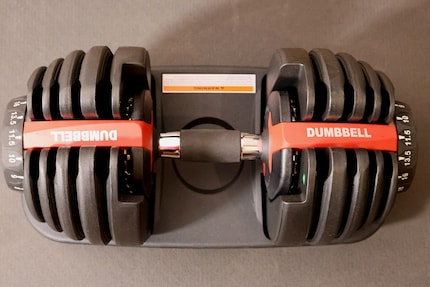
In addition to taking up very little space, the dumbbell excels at versatility. You can do isolated exercises like bicep curls with the low weights, or bench press with the entire 24 kilogrammes. That’s not enough for you? These Fitcom dumbbells also come in a set with five to 40 kilogram weights.

The advantage of this is that you can start with a low weight and gradually increase it. As you get stronger, you won’t need to buy new equipment.
It’s also great that you have options if you want to train with friends or family members – regardless of whether they’re just starting out with strength training or are already built like a tank, pushing fully loaded dumbbells. In two simple steps you can switch them back to your preferred training weight.
Who are the dumbbells for?
Let me start by saying: if you regularly go to the gym or are really experienced in strength training, these dumbbells might not be suitable. The relatively low total weight and the somewhat bulky shape limit their usefulness for ambitious strength athletes.
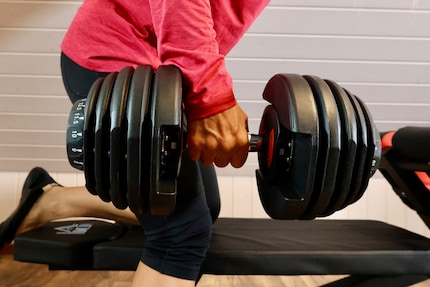
If you’re an endurance athlete and want to incorporate strength exercises into your training to prevent injury or – like me – want to do a few exercises at home without any complications, then read on. After all, dumbbells provide the opportunity to do something for your muscles. Even if you can’t perform all exercises in a textbook manner, it’s definitely better than giving up strength training altogether.
Grab your plates
The dumbbell (yes, I only have one...more on that later) seems well made. It rests on a plastic stand – which you need to safely place the dumbbell onto when you want to change the weight. All you have to do is turn the dial which has the respective kilo numbers written on.
When I’ve set the desired weight, I hear a click and only the selected plates connect to the dumbbell. The others remain in the stand.
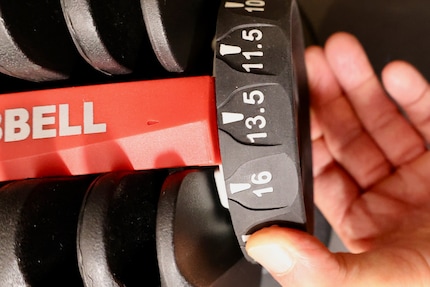
I was confused by two things. Firstly, the change from kilo toone and a half to two kilo increments. It goes from 11.5 to 13.5 then to 16 kilos. The second was the fact you have to adjust the weights on each side, instead of once in the middle like many other dumbbells offer. Neither is a bad thing, it just takes a bit of getting used to.
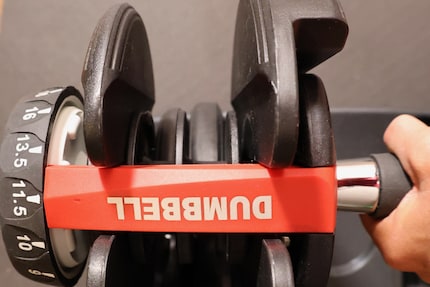
What I find more annoying is that the spacers that hold the weights in place are made of plastic and not metal. This makes the construction feel less robust and secure. Although the mechanism always worked reliably for me and the plates stayed in place, the slight rattling and wobbling still made me doubt it a little.
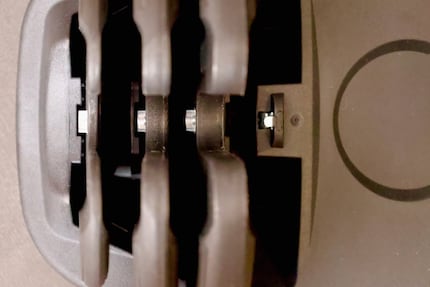
I also noticed that it would sometimes jam when I put the dumbbell back on the analogue charging station. It works best if you hold the dumbbell very straight.
Here’s how they fare during a workout
Many dumbbell workouts require two dumbbells. I start with just one because I already have a lot of different weights on this one. And because of the size of the dumbbell. The length doesn’t change, whether I train with 2.5 kilos or 24 kilos. Initially, I thought it was a flaw, because for my height (164 centimetres) the dumbbell seemed too big.
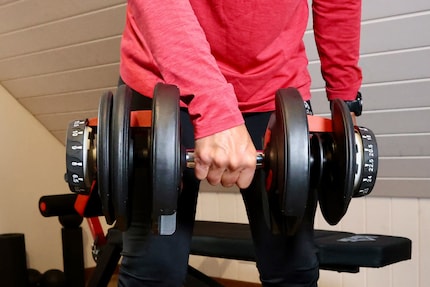
In reality, however, things go much better than expected. Instead of two dumbbells when bench-pressing, I hold the dumbbell by the outside of the discs and it works. All I have to do is make a few adjustments and I can keep up my training.
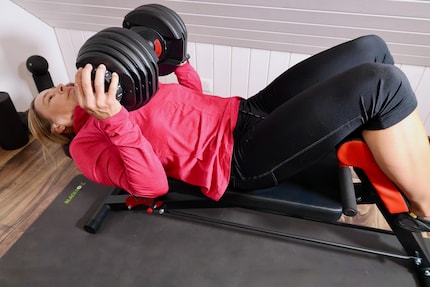
Does the dumbbell help me exercise regularly?
I chose a dumbbell-focused, four-week strength training program from Garmin. The workouts last between 30 and 45 minutes and consist of a warm-up set and then the main sets with exercises such as lunges and squats with dumbbells, shoulder presses, bicep curls and bench presses. The weights are specified by Garmin as easy, moderate or challenging, so I can choose how much I want to work my muscles.
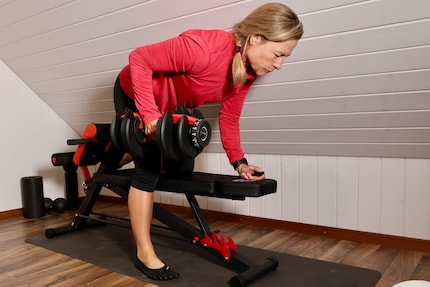
The workout reminds me of strength circuit training. Each exercise phase is followed by 30 seconds of rest. The Fitcom dumbbell is ideal for this type of workout – 30 seconds between exercises is sufficient to adjust the weight accordingly. And I can track my progress by taking slightly heavier weights from week to week.
My four-week training program with three sessions per week is now over. I’m pretty certain I wouldn’t have finished it if I didn’t have the reminders on my Garmin watch. Still, I can say that the uncomplicated handling of the Fitcom dumbbell and the various weight settings made the workouts easier and more efficient.
In a nutshell
Space-saving option for your home gym
If you’d like to train at home but have little space, Fitcom’s adjustable dumbbell could be a good solution. It allows you to adjust the weight to the respective exercise and your fitness level in no time at all. Especially if you’re just beginning your strength training journey, you won’t have to buy heavier dumbbells every time you make progress.
The fact it’s so versatile allows family members or anyone at home to join you in your lifting session without wasting time changing plates.
The dumbbell helped me to complete a strength-building workout for four weeks. Overall I’m satisfied, but the size of the dumbbell isn’t ideal, even for low weights. The plastic parts of the adjustment mechanism make the dumbbell seem less robust. It also rattles slightly. Everything on mine stayed in tact, but I’d still prefer a more stable construction with metal.
Pro
- Weight adjustment in no time at all
- Wide range of weights for many exercises and levels
- Saves space
- Cheaper than buying the same number of individual dumbbells
Contra
- Too bulky for some exercises due to its size
- Plastic fixtures don’t seem super stable
Research diver, outdoor guide and SUP instructor – I love being in, on and around water. Lakes, rivers and the ocean are my playgrounds. For a change of perspective, I look at the world from above while trail running or flying drones.
